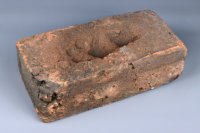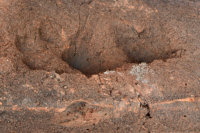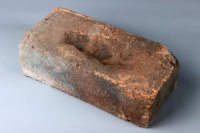Convict Made Brick, circa 1835
1972/151


Massacre
Wirrayaraay people seeking sanctuary from a particularly violent summer in 1838, camped with permission and supposed protection on Henry Dangar’s property at Myall Creek. On June 10, they were slaughtered without warning by white stockmen. The remains of at least 28 people were later observed but the final death toll remains unknown. Massacres of Aboriginal people were usually overlooked. The Myall Creek Massacre perpetrators were tried twice in the Supreme Court, and despite Henry Dangar working for their defence, they were found guilty and executed.Cartographer
This brick is from Neotsfield Homestead, just one property in Henry Dangar’s pastoral empire. Exploring and mapping much of Northern NSW in the early years of European settlement fell to Cornishman Henry Dangar. He arrived in Australia in 1821 and used his role as a surveyor to secure farming land of his own.Convicts
When Europeans first began occupying Australia, bricks, a crucial building material, were made by convicts. Crushed seashells and human hair were some of the more unlikely ingredients used to make early Australian bricks. Most were used for government projects, but convicts could make bricks like this one for private citizens in their own time.Architecture
This brick was taken from Neotsfield homestead in the 1970s. Neotsfield was built between 1833 and 1838 and is an excellent surviving example of early Australian colonial architecture. It had wide verandas and was designed around a three-sided courtyard. It was modified over a period of 50 years and today boasts 29 rooms.


Convict Made Brick,
circa 1835
1972/151


Massacre
Wirrayaraay people seeking sanctuary
from a particularly violent summer in
1838, camped with permission and
supposed protection on Henry
Dangar’s property at Myall Creek.
On June 10, they were slaughtered
without warning by white stockmen.
The remains of at least 28 people were
later observed but the final death toll
remains unknown. Massacres of
Aboriginal people were usually
overlooked. The Myall Creek Massacre
perpetrators were tried twice in the
Supreme Court, and despite Henry
Dangar working for their defence,
they were found guilty and executed.
Cartographer
This brick is from Neotsfield
Homestead, just one property in Henry
Dangar’s pastoral empire. Exploring
and mapping much of Northern NSW
in the early years of European
settlement fell to Cornishman Henry
Dangar. He arrived in Australia in 1821
and used his role as a surveyor to
secure farming land of his own.
Convicts
When Europeans first began occupying
Australia, bricks, a crucial building
material, were made by convicts.
Crushed seashells and human hair
were some of the more unlikely
ingredients used to make early
Australian bricks. Most were used for
government projects, but convicts
could make bricks like this one for
private citizens in their own time.
Architecture
This brick was taken from Neotsfield
homestead in the 1970s. Neotsfield
was built between 1833 and 1838 and
is an excellent surviving example of
early Australian colonial architecture.
It had wide verandas and was designed
around a three-sided courtyard. It was
modified over a period of 50 years and
today boasts 29 rooms.



